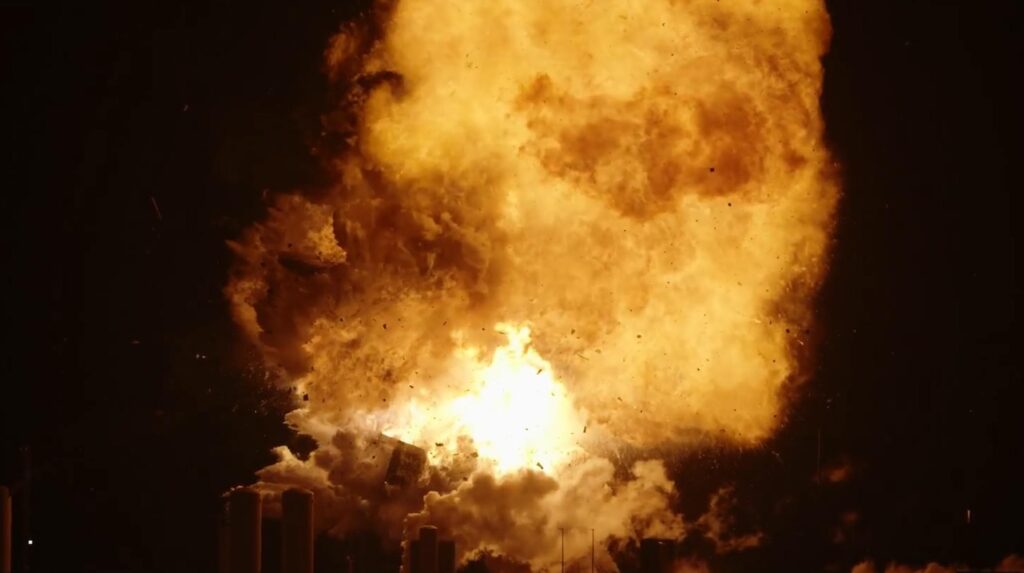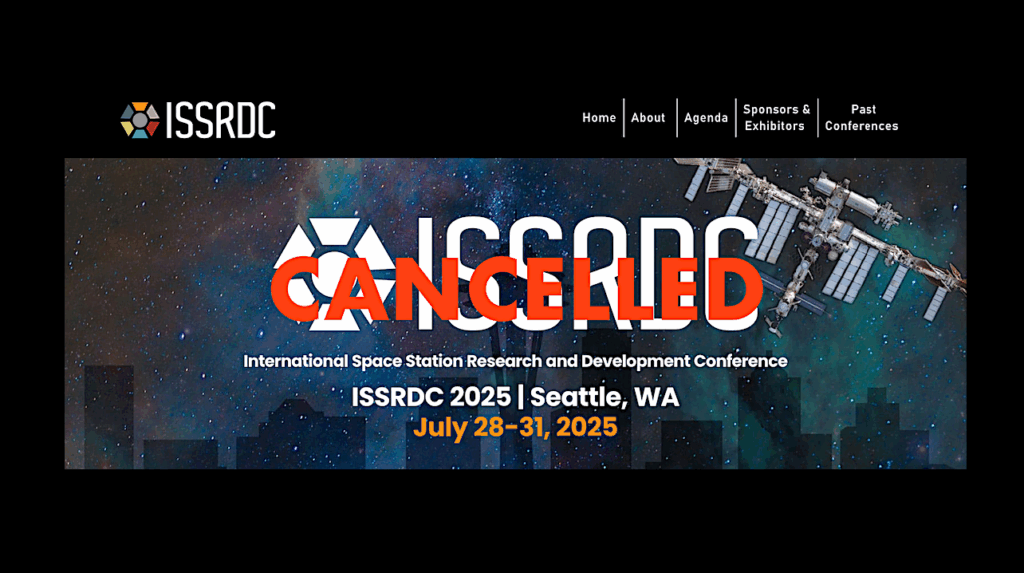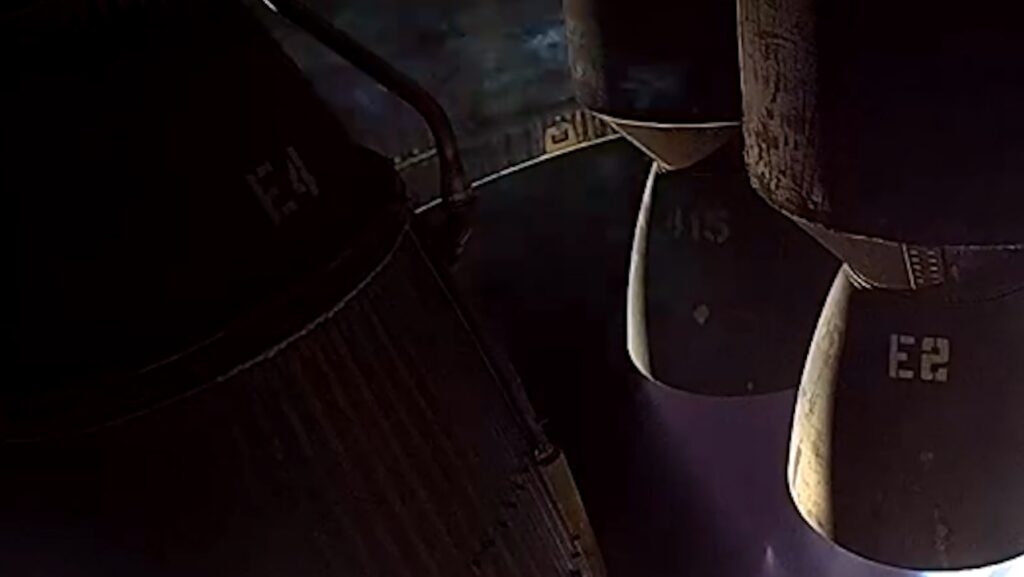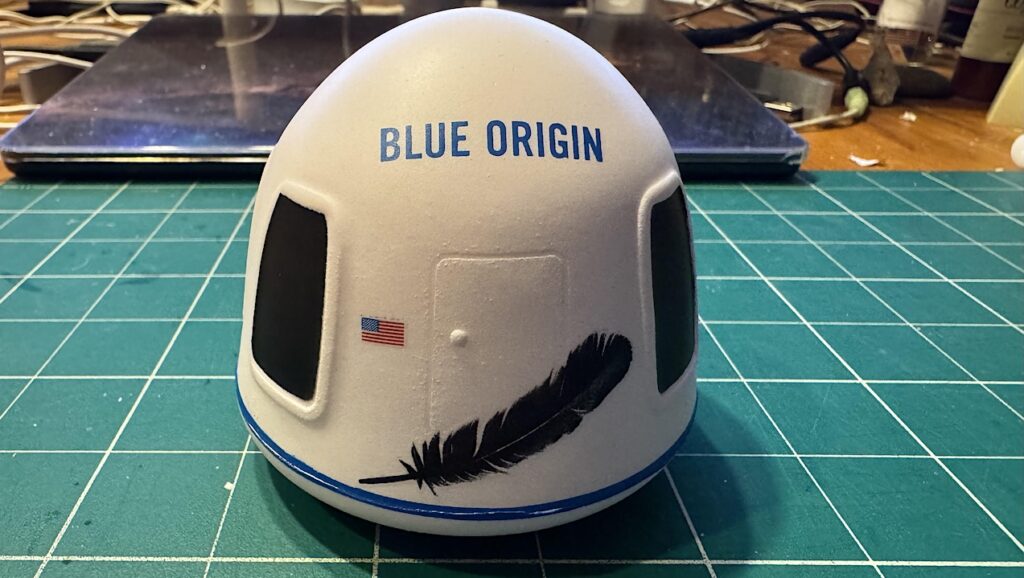SpaceX to Reveal Dragon V2 Thursday
 SpaceX to Unveil Dragon V2 for Manned Spaceflight Thursday, SpaceRef Business
SpaceX to Unveil Dragon V2 for Manned Spaceflight Thursday, SpaceRef Business
“True to his word, SpaceX CEO Elon Musk will unveil Dragon V2 this Thursday, May 29th at SpaceX HQ to invited guests. SpaceX is calling the Dragon V2 “a next generation spacecraft designed to carry astronauts into space.” It was April 29th that Musk tweeted that the “cover drops on May 29. Actual flight design hardware of crew Dragon, not a mockup.”
Related Update: SpaceX Completes Qualification Testing of SuperDraco Thruster [With video]
“Space Exploration Technologies Corp. (SpaceX) announced today that it has completed qualification testing for the SuperDraco thruster, an engine that will power the Dragon spacecraft’s launch escape system and enable the vehicle to land propulsively on Earth or another planet with pinpoint accuracy.”









There was a pic momentarily on the ‘net over a week ago showing very different SuperDraco pods than the “noses” on the older mockup. Higher, broader and flatter faced pods with a more vertical thrust line and somewhat asymmetrically placed around the spacecraft. Looked like a model in a wind tunnel. We’ll see how correct it was.
See here for the just released image and video: http://spaceref.biz/company…
That purported wind tunnel pic has reappeared. Boost the gamma and it looks like it is in a wind tunnel. We’ll see tomorrow night.
https://warosu.org/data/g/t…
She’s looking like she’ll be a pretty lady. I’m looking forward to seeing the full-scale machine.
Looks pretty badass to me.
According to that link the Super Draco produces 16,000 lb-f of thrust.
According to Wiki the RL-10 produces 14,545-24,729 lb-f.
So 3-4 Super Dracos are sufficient to provide the main thrusters on a Xeus style lunar lander, without the boil off problems.
Amazing to see Orion spend billions $$ and a decade and they keep advertising they’ve tested a parachute line or whether it will float in water, and that a real unmanned test is still 5 or 8 years in the future, and maybe a manned test in another decade and many billion more, when Mr Musk rolls out a real vehicle in a day. Godspeed manned Dragon.
Orion’s unmanned test flight is slated for December of this year.
http://en.wikipedia.org/wik…
On a $$$$ Delta IV Heavy, not its opetational config & mainly a heat shield test. The way the SLS is slipping its first Orion flight may not be until 2018+ and it may not carry crews until 2022, depending on the other test flights.
i know what they are testing. my point was that Littrow was incorrect when he said there would be no Orion test flight for 5-8 years.
Hug Doug you are a good example of the kind of folks NASA is counting on make up 98% of the taxpaying electorate, responding to their continuous stream of high 5’s and successfully passed tests by thinking they are actually accomplishing something of significance with all those billions of dollars. When in reality the flight test this year (or next) is not a full fledged Orion-it is just a partial systems test. NASA obfuscates. Gerstenmaier last week laid it on the line when he said we don’t want people to know how much it is really going to cost or how long it is really going to take, because if they knew they probably would not permit it to continue.
“you are a good example of the kind of folks NASA is counting on make up 98% of the taxpaying electorate”
i should hope so. since i’m someone who knows what the facts are and corrects the errors of the misinformed.
i know what they are testing. Littrow was incorrect when he said there would be no Orion test flight for 5-8 years.
If you’re going to correct “the errors of the misinformed,” at least quote them correctly. Littrow said: “a REAL unmanned test is still 5 or 8 years in the future.” He’s talking about Orion and SLS.
Well, being perpetually cynical isn’t *always* health.
I agree, we should not distort the facts in either direction. Orion is indeed preparing for an unmanned test flight. Ironically it is a test flight on the very LV that was eliminated form contention in the Exploration Systems Architecture Study on the basis that it lacked the required performance, was too expensive to man-rate (due to an arbitrary load factor requirement of 1.4), and imposed nonsurvivable abort zones due to its lofted LEO insertion trajectory.
And yet, the facts on Orion are quite damning.
1. By the time Orion takes it’s maiden flight in 2021 aboard SLS, with crew, the project will have spent over $23 billion.
2. According to the recent GAO report, everything about Orion (and SLS) costs gets murky after the first flight of SLS (in late 2017) and Orion (in 2021).
3. It’s reasonable to say that the Orion yearly budget, which has run about $1 billion a year, will carry through into manufacturing or launch years. This is what cost-plus projects do, how they nearly always behave. Given potentially low flight rates, Orions per unit costs could be in the hundreds of millions or up to $1 billion on recurring costs alone. Or much higher than billions a unit if including development costs. (The costs any year Orion does not fly would just accrue to calculating when it does.)
3. Orion will carry up to 6 crew.
Compare that to an example contender from the commercial crew program, Dragon.
1. Including the Dragon work from the cargo-version development, which was in the low hundreds of millions, a crew capable Dragon development is looking to end up in the high hundred of millions, likely under a billion, sum total.
2. Current cargo Dragons are in the range of $75-100M a unit. Crew versions, if even double or triple, excluding the launcher of course, would still cost orders less (remove a zero) than Orion per unit, per year, or using lifetime NASA investment costs divided by flights or units purchased.
3. Dragon will carry up to 7 crew.
Technically this is where the usual distinction arises that Orion is larger, made for beyond Earth orbit missions, without noting that Orion is not a habitat. Orions, Dragons, Dreamchasers-all just ways to carry crew to LEO. Habitats and such will always be separate.
Technically, another distinction often made is that the heat shields are for differing re-entries, with Orion made to come in faster (having come from beyond Earth orbit), vs. Dragon (coming from the ISS). This is actually a nuance, not a significant technical difference. Dragon could easily be modified slightly and/or certified for the additional range. Does anyone think the later would explain a $22 billion dollar difference? Or that the mod would cost as much?
Take all the NASA money spent, including development, divide by some flights by some date. It’s not that hard.
Imagine what habitat or in-space system or instruments and science could be had merely using Orion’s yearly burn rate of a billion dollars, going forward, but using cheaper means to get to low Earth orbit. Just imagine. So you see, something is really off here, no denying it.
I’m a bit afraid for the safety of Orion, purely due to the extremely small number of flights it will have before going straight to doing Lunar and Mars Missions, and currently only planned for four missions in total, I believe.
Contrast that with Dragon, which already has five flights under it’s belt. Three more planned for this year alone, 12 in total for CRS, but it’s pretty much guaranteed that the contract will be extended repeatedly. And likely a huge number of manned flights also – flights that will have a launch escape system capable of being activated at any time in the flight.
Orion going so far from earth with so few flights under it’s belt makes me nervous.
Abort testing of the SpaceX design is approaching 1 year late. The pad abort and in flight abort tests will be the critical items to determine when they’ll be ready for people to fly their vehicle into space.
Thomas
This is not just a capsule that is a little late with its abort system.
This thing is a lander! A human rated lander! It can land on any rock around. Since it is Musks, not public Space, they can’t kill it. It will grow! It will morph! It is the seed of future Space travel. It is the fruit of all you have worked for. I don’t understand why you don’t see it.
To me you sound like a father that looks at his child and is jealous of their youth and potential.
Also Musk has the golden egg, recoverable rocket boosters. Other countries and companies will have to copy or compete. I listioned when you spoke about engine materials and other fuel types. I still don’t know near enough. But in the last few weeks It seems the fuel of choice will be methane. Isn’t that the best choice to fuel up in outer Space?
Well today is a big day
Some would say PT Barnum is about to do it to us again.
Lol
Let’s just enjoy the show!
What do any of your comments have to do with SpaceX running late on this test?
When the current contract was awarded, they were scheduled to perform the pad abort test last October I believe. Looks like they will do it a year late. I would assume they knew what this system would do when the contract was awarded and what the schedule was.
While this is a complicated issue and delays are not unexpected, this is just a reminder for some realism when SpaceX puts out some date that it is likely to be later than announced.
The pad abort milestone was last Dec. The inflight was last April. Both are scheduled for July and Aug. Not real close to a year, but a big delay. They have the capsule so they may make it this time. Dragon V2 not DragonRider though.
I think DragonRider is the internal SpaceX program name whereas Dragon V2 is the first Dragon Crew vehicle.
Cheers.
Your cheerleading completely missed the point(s) of his statement and is completely irrelevant.
With that said, SpaceX will very likely still fly men well before Orion, even with SpaceX’s delays.
John Thomas, you should apply your scrutiny equally to the Orion program.
16 minutes to show time.
Goooooooooo team!!!
Tom Thumb
Speculation is rife as to what will be revealed. Can’t wait.
Cheers
Shoot! And here I am going through the trouble of getting our trampoline man-rated!
C’mon Elon, just for sh*ts & giggles, can you release a rendering of Dragon with warp nacelles or something?…
Silver Dragon. We have a human rated moon lander. 🙂
I wonder what 120000 lbs of Super Draco thrust sounds like inside the Dragon. I guess better deaf than dead…
if the Astronauts complained about the PRCS on the Shuttle sounding like a howitzer, I can only imagine
Excited but would also like to see their suit design.
How many times can super draco relight before it blows up? What is the suspected life of this engine? thus the life of a dragon lander? The dragonfly program sounds like it will be testing a dragon many times to learn theses answers. Guessing they may use the same test vehicle over and over. 38 planned hops I think. Image a dragon hopping back and forth from the moon to a fuel depot in lunar orbit or L2 a hundred times helping to make an affordable highway to the moon.
Dragon v.2.0 itself is too small for the lunar lander mission but Super Draco is a pretty good engine for this role, especially if they stick a decent vacuum nozzle on the bottom. I’m sure that the crew vehicle abort/landing test program would generate a lot of data that would be useful in such a development program.
If it lasts. They have a no parachute landing with only a 5 sec. burn in a drop from a heli. They also will land on the Trunk sometimes. Since that is dropped off in orbit the only test that would be for is a Moon landing and take off. Open a hatch and drive out a rover and win the X prize. Unless they are putting the heat shield on the rear of the trunk. Reuse the Trunk that way.
“…an engine that will power the Dragon spacecraft’s launch escape system and enable the vehicle to land propulsively…”
This statement has been widely reported in the past, but does anybody know how it would land after a launch abort? Does it carry enough fuel to preform both a launch abort and a landing, or is there a backup landing system if the launch abort system is used? If there is fuel for both functions, does that mean it carries the launch abort portion of the fuel in a nominal landing, or does it dump that fraction of the fuel sometime prior to landing? If the latter is the case, at what point does it dump the excess abort fuel – during launch, after orbit is achieved, after reentry, other? Is the launch abort system sized to provide full coverage of the launch sequence from pad abort to orbit?
Thanks in advance for any answers.
Launches will be over water, launch aborts (including pad aborts) will come down by parachute into the ocean. For a particular mission the SuperDracos will be used either for launch abort or for nominal mission landing, not for both
Indeed exciting…unveiling webcast here…
http://www.spacex.com/webcast/
Due note that it has a very cool “Trunk Release”…BUT does it have…
https://www.youtube.com/wat…